🎥 Video: How Retailers Use Gamified Loyalty to Outperform Competitors.
Save your seat.


The loyalty program for eCommerce can be one of the most effective ways to increase customer retention, repeat purchases, and brand engagement. In this article, we explore successful examples and what makes these loyalty strategies work so you can apply the best ideas to your own business.
You need to know that we're not only loyalty experts — we're also customers. We've grown to appreciate smooth, rewarding online shopping experiences, and if something disrupts that flow, we simply walk away. The same goes the other way: when we find something exciting in an online store, we tend to stick with it because it feels good.
We've realized that nearly every online purchase we make ends up involving some kind of loyalty card or incentive. Saving on purchases and gaining additional benefits is something customers genuinely value. At the same time, we've noticed how creatively eCommerce websites use loyalty strategies to encourage more frequent, larger, and more varied orders.
That's why we took a closer look and researched real programs, analyzed community feedback, and compiled a list of the top 10 eCommerce loyalty programs that stand out. Below, you'll find key features, smart mechanics, and inspiring examples that can shape your next loyalty initiative.
The eCommerce industry has undergone a dramatic transformation over the past decade. What began as a convenient alternative to in-store shopping has become a dominant global channel. Consumers now expect speed, flexibility, and personalization in every online interaction, and eCommerce businesses are racing to keep up.
One of the most notable shifts is the normalization of cross-border shopping. Borderless eCommerce, supported by mobile devices, global payment systems, and localized digital experiences, is reshaping how brands expand and compete. The stage is now set for sustained digital growth on a global scale.
The global eCommerce market continues its upward trajectory, with digital commerce firmly embedded in the way consumers shop. According to Shopify, eCommerce is expected to generate $4.8 trillion in global revenue in 2025, accounting for approximately 21% of all retail sales worldwide. By 2027, that number is projected to rise even further, as borderless eCommerce becomes the norm across product categories and regions.
Data from Custom Market Insights supports this view. Their report projects that the retail eCommerce market will grow to $7.9 trillion by 2032, reflecting a compound annual growth rate (CAGR) of 8.5%. This long-term growth is fueled by several key drivers:
Regions such as Asia-Pacific, Latin America, and parts of the Middle East and Africa are seeing especially rapid growth, driven by improved internet access, mobile-first behaviors, and supportive government policies for digital trade. Meanwhile, established markets like North America and Europe continue to expand through innovations in omnichannel experiences and last-mile delivery.
Competition is fierce, and customers have high expectations. If you want to grow, your eCommerce business needs more than just attractive prices and a wide range of products. Loyalty programs, such as point systems, tiered membership, or experience rewards, give brands the tools to increase customer retention, repeat purchases, and customer lifetime value.
Until recently, stores' life and growth cycle were clear — first, you invest in a brick-and-mortar store. Then, if there's high customer demand, you can open an eCommerce store to become ever more approachable. However, conventional stores seem to be insufficient for modern consumers, especially since their operating models don't fit the three visible and strong trends I'll list below. For this reason, business owners create "pure eCommerces" that operate exclusively online from the very start.
Mobile commerce (mCommerce) refers to the buying and selling of products and services through wireless portable devices like smartphones and tablets, and it now represents a major share of global eCommerce. As of 2025, global mCommerce sales are projected to exceed $2 trillion, accounting for approximately 57% of all eCommerce transactions worldwide.
This shift is driven by both consumer behavior and technology. Mobile shopping offers speed, convenience, and personalization letting users discover, browse, and purchase without switching devices or entering a store. In markets with younger, mobile-first populations, such as Southeast Asia and Latin America, mobile commerce is often the default channel.
To meet these evolving expectations, companies are investing in mobile-optimized experiences, including:
As mCommerce becomes the primary mode of online shopping, eCommerce loyalty programs must adapt. Mobile-first loyalty systems, with real-time notifications, in-app rewards tracking, and seamless redemptionm are essential to keeping shoppers engaged and returning.
Personalization has become a fundamental expectation in eCommerce, and it directly impacts loyalty. According to recent research, 76% of consumers say they are more likely to become repeat buyers when personalization is done well.
In physical stores, salespeople cannot spend too much time with one customer because it's inefficient. Worse, sometimes existing customers just don't want to be bothered and wish to be left alone in their journey. This is nothing but a missed opportunity to convince them to buy your goods, which is why an online store gives you an edge and allows you to provide a personalized experience to every customer who visits you.
When you run your own online store, you can get so much data about your shoppers to increase ROI, conversion rates, Average Order Value (AOV), and sales. Take advantage of it! Conduct deep data mining, analyze datasets, and use artificial intelligence tools to uncover incredible insights. You truly have everything you need to track your customers' buying behavior and customize their journey.
Turning data into knowledge allows you to create a hyper-personalized customer experience. And I'm not talking about a single shopper, but a whole customer base. An eCommerce store will enable you to develop individual strategies, influence shoppers' decisions, retain existing customers, tailor your products or services to their needs, and create stronger bonds.
The more prominent players know that the eCommerce industry is moving toward APIs, microservices, and progressive web applications (PWAs), and I hope you're already on to that. Microservices architecture can definitely give your online store the flexible foundation you need to grow as a business.
If you move to headless eCommerce, you can scale the front-end and back-end individually. Also, a microservice-based store is the backbone of a decentralized development process. Simply put, it's easier for your development team to cooperate and fine-tune your codebase to deliver new eCommerce features to the market. Last but not least, you can add only those microservices to your technology stack that will serve specific business purposes. No more useless functionalities and technology debt that is hard to work on.
Progressive web apps are another, but also noteworthy, eCommerce store development approach. First, you can use your PWA to hit a wide audience since they're designed to work for any user, regardless of their preferred platform. Also, you can save a lot of money and time because you don't have to create separate shopping apps for Android, iOS, and Windows 10 in addition to your online store. Another advantage of PWAs is that they're extremely fast, reducing the chances of abandoning your eCommerce and ensuring a higher conversion rate than native apps.
So far, so good, but with new trends come new pressures. I found two general challenges that all eCommerce managers face every day.
It's more profitable to market to previous customers than people who have never shopped with you before. However, it's still difficult to turn one-time shoppers into lifelong customers, especially if you don't have the right mix of goods or services, MarTech tools, and strategies to win them over. If you feel like you're struggling, try to find the real reason why the existing and repeat customers buy from you. And I won't deny that it requires a tremendous amount of work from professionals across multiple disciplines such as sales, customer loyalty, support, customer success, marketing, social media, data analytics, and so on.
It's much easier to lose a customer to a competitor online. A customer may simply move on to the following search result or read a negative purchase story in your store on a forum and exclude you from their considered options. You have to be persuasive at every customer touchpoint, and that's a costly and resource-intensive task.
Fine, we generalized a bit by listing just two eCommerce challenges here. Of course, there could be more depending on the product/service offerings, eCommerce business policies, target market, and customer group demographics or psychographics. Nevertheless, the solution to prevent customer churn and make them more loyal is almost within reach — it's called an eCommerce loyalty program.
An eCommerce loyalty program is a system designed as a seamless part of the customer journey to create a proactive community around your brand and offerings.
Loyalty programs vary and can be based on simple mechanisms related to upgrading to higher tiers, earning points, and receiving simple rewards, or those that combine multiple mechanisms at once, including gamification and gaining new achievements. Whatever components your eCommerce reward software consists of must be easy to understand and provide an enjoyable experience.
There are various types of successful loyalty programs available to cater to the diverse needs of eCommerce businesses. The primary loyalty programs for eCommerce businesses include:
A points-based loyalty program is the most straightforward type of loyalty program. It is based on the concept of accumulating points through spending, which can be redeemed for rewards such as discounts, freebies, and exclusive items, ultimately increasing customer lifetime value.
Tiered loyalty programs, on the other hand, reward customers based on their level of loyalty, with higher tiers providing more benefits as customers purchase more, extending their customer lifetime.
Other types of loyalty programs, such as value-based, universal, and paid programs, offer unique benefits to customers. Starbucks Rewards program is a successful example of a value-based loyalty program.
Selecting the right type of loyalty program for your eCommerce business depends on factors such as your target audience, industry, and goals. By understanding the different types of loyalty programs, you can choose the one that best suits your business needs and creates a rewarding experience for your customers.
Get the most out of your loyalty program and choose from market-proven loyalty campaign templates.
Now that you know what the eCommerce loyalty program is, it's time to explore the most important goals and objectives of an eCommerce loyalty system, and they are:
You need an eCommerce customer loyalty program if you're an online retailer and:
If any of the above points fit you, then it's time to make a decisive business move — create a dedicated and influential customer loyalty program for your eCommerce.
Perhaps you don't know how to get started, and there's just a blank space in your head right now. No worries! Read on and learn about the ten most successful eCommerce loyalty systems to get inspired.
Newegg is a California-based online retailer of computer hardware and consumer electronics items. They've been in business since 2001 and have amassed a loyal customer base of over 40.2 million users who are always looking for the latest and greatest tech products.
The company has deepened its relationship with customers in 2020 by launching the EggPoints Program. This eCommerce loyalty system was designed to recognize and reward customers for what they already do on the Newegg website.
So, the average customer who joins the EggPoints Program can get more points for:
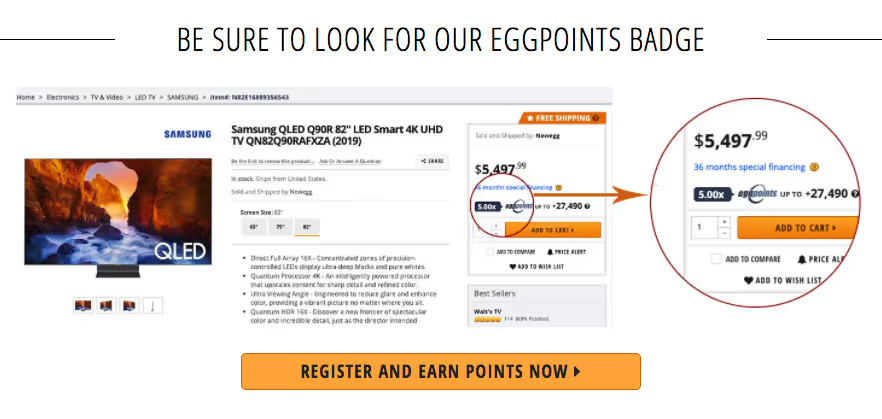
The rule is simple: One hundred EggPoints is equivalent to one dollar. When customers earn EggPoints through purchases, they can make one point for every pre-tax dollar spent on an eligible item. Once EggPoints are available to use, customers have 90 days to redeem them before they expire. So, as you can see, customers are motivated to be proactive and revisit to avoid losing points.
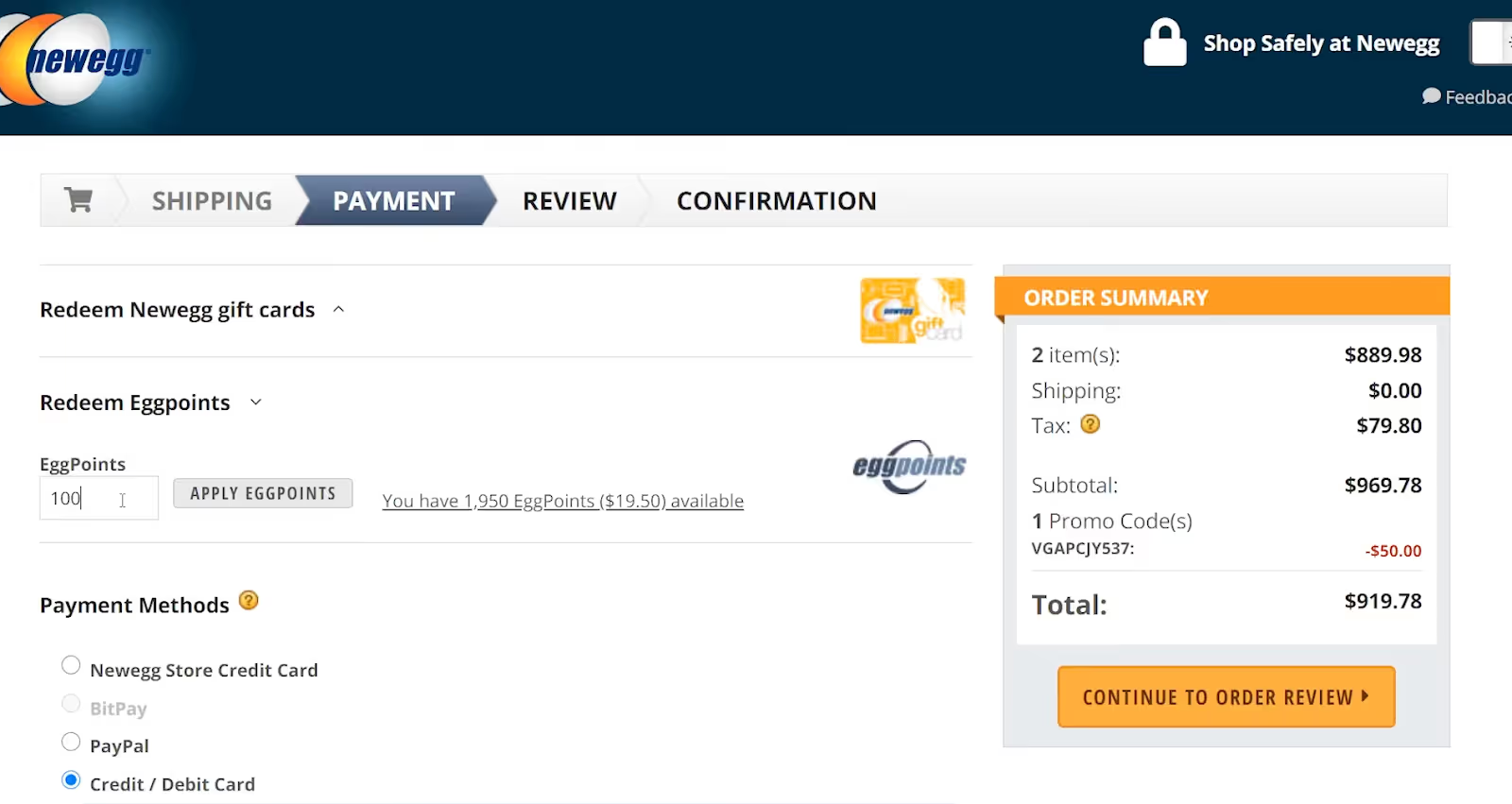
EggPoints are only redeemable on Newegg.com so customers can only buy Newegg products. This is a smart move because people are motivated to purchase more things just based on Newegg's offer. In addition, loyalty program managers can easily spot patterns and products in high demand when redeeming points. They can use this knowledge to plan future campaigns, increasing the value of the shopping cart.

FARFETCH Limited is a leading global platform for the luxury fashion industry. In 2008, FARFETCH started as an eCommerce marketplace for luxury boutiques worldwide. Today, they connect customers in more than 190 countries with items from over 50 countries and more than 1,400 of the world's top brands, boutiques, and department stores.
Their goal is to connect creators, curators, and consumers and provide a truly unique shopping experience on a single platform. With this mission in mind, FARFETCH launched their own reward loyalty program — Access — as an extension of the customer journey.
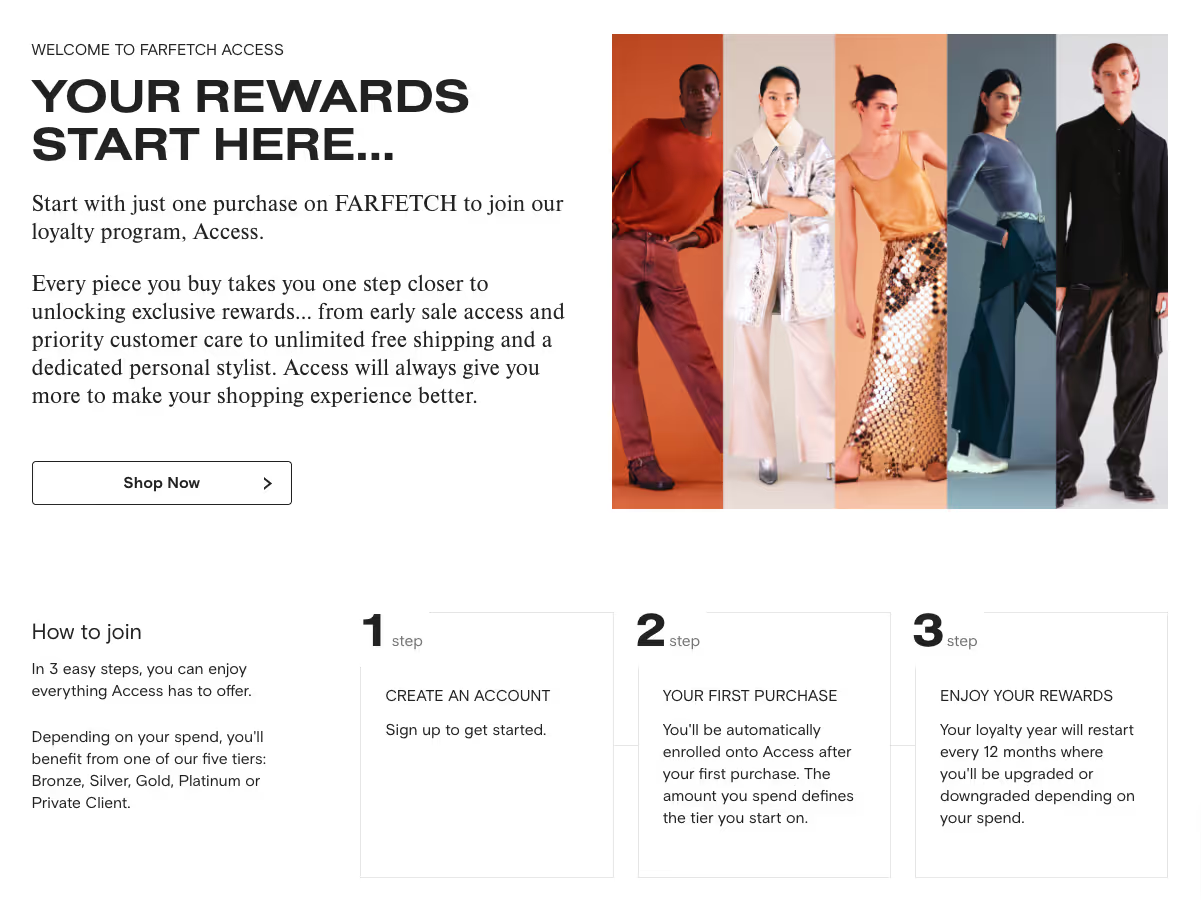
Customers can join the Access loyalty program in just three easy steps:
The customer loyalty program restarts every 12 months, and based on customer purchases, they either upgrade or downgrade. Now, customers are divided into five tiers according to their spending, which are:
The customer needs to make just one purchase, and they get:
The customer needs to spend $1,200, and they get:
The customer needs to spend $2,400, and they get:
The customer needs to spend $6,000, and they get:
The customer needs to spend $12,000, and they get:
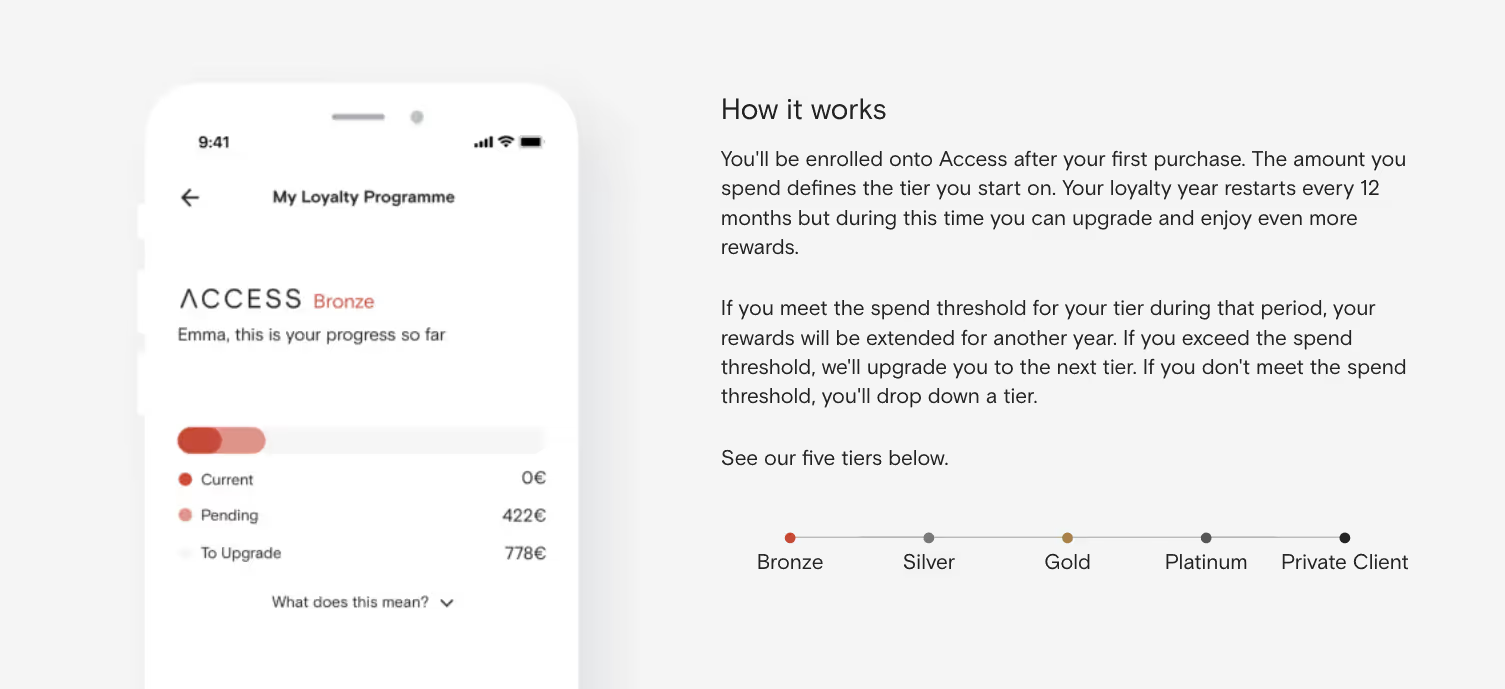
This customer loyalty program is a real treat for all fashionistas. As you can see, there are some essential benefits, and then, from tier to tier, there are even more exclusive perks.
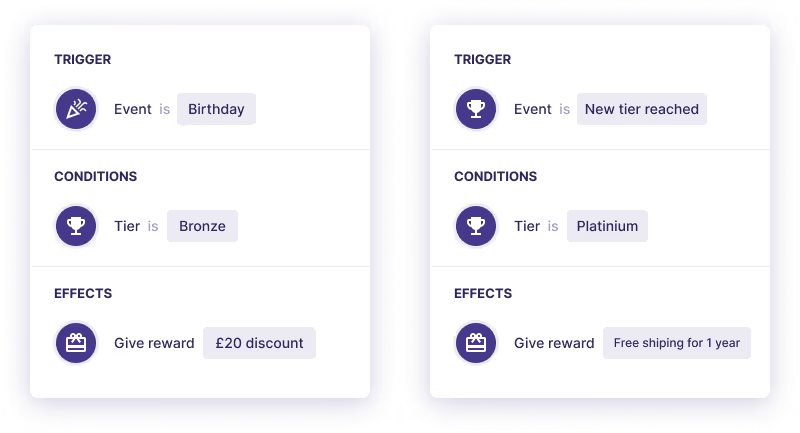
Flipkart is India's largest online retailer and a key player in the country's eCommerce ecosystem. Acquired by Walmart in 2018, Flipkart has continued to grow steadily. Its marketplace arm generated ₹17,907 crore (~$2.2 billion) in revenue in FY2023–24, while overall revenue reached ₹70,844 crore (~$8.3 billion) — a 26% year-over-year increase.
To drive retention, Flipkart launched Flipkart Plus in 2018 — a free, points-based loyalty program. Members earn 4 SuperCoins for every ₹100 (~$1.20) spent on eligible purchases. To qualify, users must earn 200 SuperCoins in the past 12 months, incentivizing regular engagement.
Key benefits of Flipkart Plus include:
With over 100 million registered customers and increasing member engagement, Flipkart Plus remains a central part of Flipkart's loyalty strategy, combining cashback-style rewards with experiential benefits to boost repeat purchases and customer satisfaction.
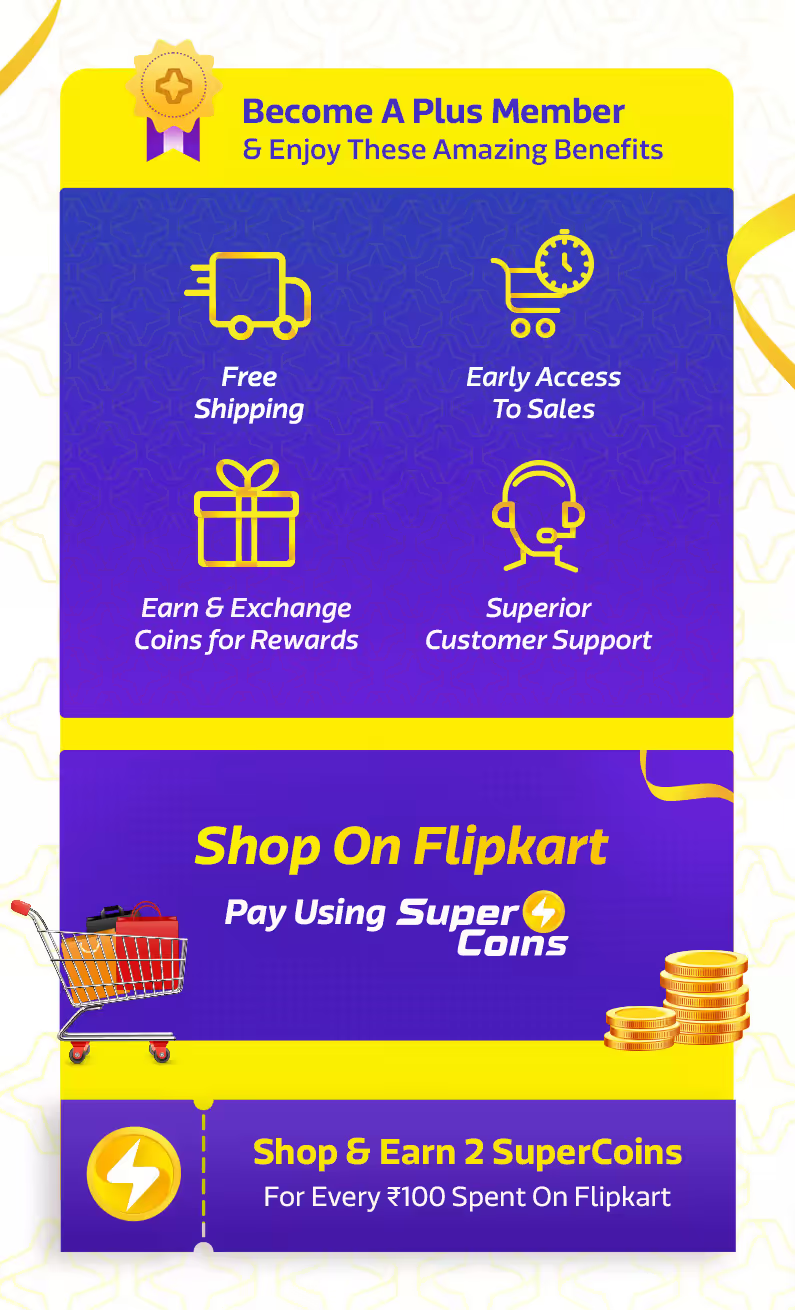
Then, members of the Flipkart Plus loyalty program can enjoy:
Also, Flipkart Plus members can earn double SuperCoin, enjoy unique Flipkart Pay Later options, and benefit from ecosystem partners in travel, lifestyle, health, and fitness. Each purchase is limited to 100 coins and has a one-year expiration date.
This loyalty system has been a huge success and achieved over 100% year-on-year growth. Around 30% of Flipkart's monthly active customers are now Plus members. On top of that, members, on average, transact 5X more and have 7X higher spending than the rest of the shoppers. Currently, Flipkart issues more than 1 billion SuperCoins per month, allowing customers to enjoy various benefits. That sounds like a successful customer loyalty program, doesn't it?
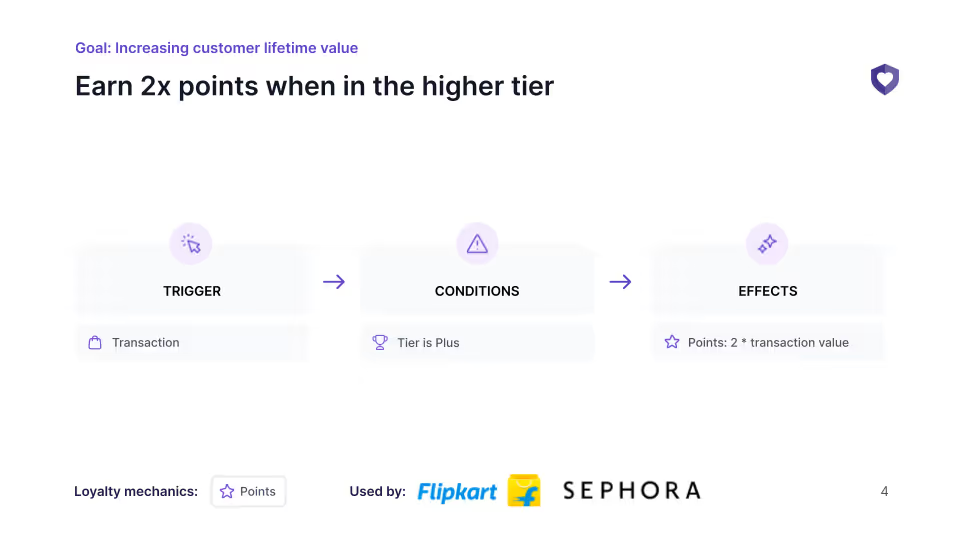
Walmart is an American multinational retail corporation that runs a chain of hypermarkets, discount department stores, and grocery stores in the United States. I think this brand needs no introduction. It's a world-renowned company that many businesses look up to, with revenues of $572.8 billion in 2022. Let's take a closer look at this eCommerce rewards system success story, though.
In 2020, Walmart launched Walmart+, a membership program that brings in-store and online benefits to save time and money. The company provides their customers with pay&go mobile applications extended with lots of promotions and special offers. Members need to pay a subscription fee of $12.95/month or $98/year to receive benefits, such as:

Walmart+ loyalty program application is an integral part of the mobile application.
According to Walmart data, their customers save $816 a year by getting weekly groceries with free delivery straight from the store. They also save up to $84 a year on gas by taking advantage of member pricing at Walmart, Murphy, and Sam's Club stations.
The ALDO Group is a global shoe retailer that wants to deliver a unique shopping experience and develop deeper, long-term relations with customers. ALDO has over 1,000 stores operating in 65 countries and plans to open stores in Italy, Norway, France, and Korea. However, they focused on three crucial markets: the US, the UK, and Canada, when creating their customer loyalty program.
In 2019, the company launched the ALDO Crew, a data-driven, omnichannel loyalty program. Their first-ever eCommerce reward system needed to provide a unified commerce approach to stay on top of consumer demands.
The ALDO Crew loyalty program includes three membership tiers: Crew, Plus, and VIP. Once enrolled in the program, all customers are automatically assigned to the Crew tier. Achieving the subsequent tiers — Plus and VIP — requires spending $150-$299 and $300+ at ALDO Crew within 12 months, respectively.
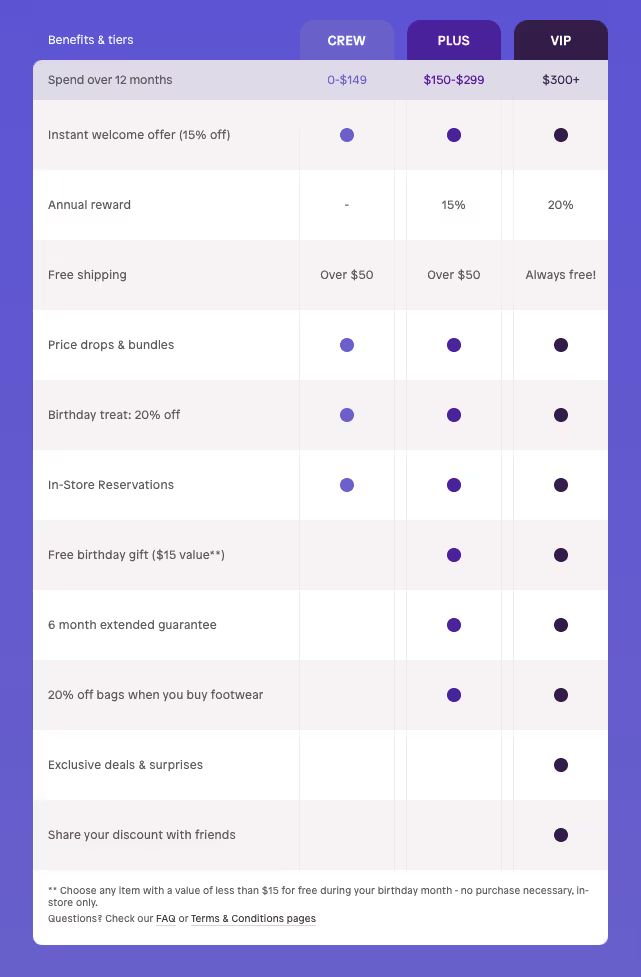
The benefits of having a Crew tier are as follows:
The higher Plus tier includes all benefits available at the Crew tier, as well:
The highest VIP tier includes all the benefits available in the Crew and Plus tiers, but also:
Joining the ALDO Crew program is very simple. Customers must provide a phone number and email address at the physical store or apply online at the website. The same is true for advancing to higher tiers. You have to be a very active customer and spend a certain sum of money to get promoted and access further perks. That's all! No small print or unnecessary fuss.
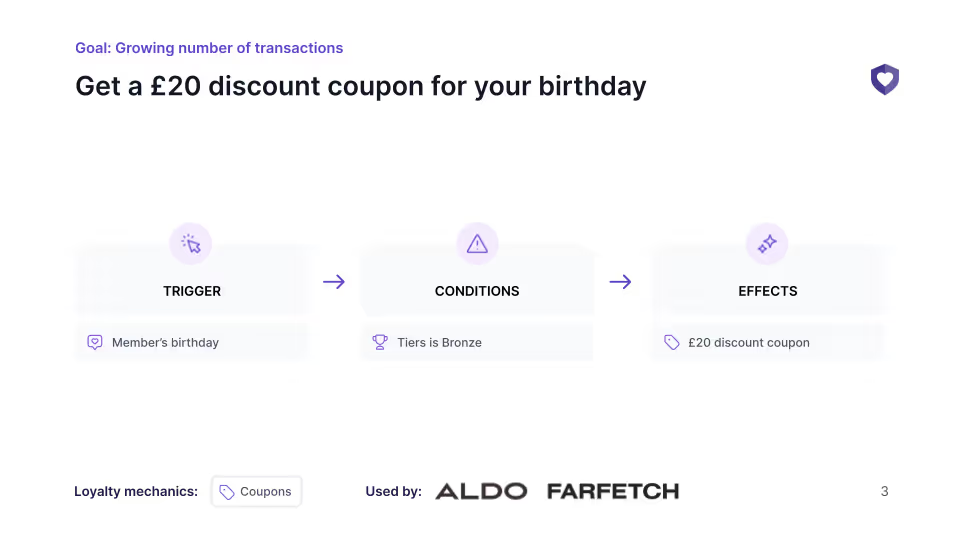
"We migrated to use Open Loyalty because it provides the business and technical flexibility needed by an enterprise-sized company like ours. With the Open Loyalty integration framework, we could match the loyalty engine with our custom needs." Thomas Archer Bata, ALDO Group
Curious about the scenes of creating this reward system? Read the full ALDO Crew case study.
SHEIN is an international B2C fast fashion eCommerce platform founded in 2008. The brand focuses primarily on women's clothing, menswear, children's apparel, shoes, bags, and other fashion merchandise. While previously valued at $100 billion in 2022, SHEIN is now preparing for a 2025 IPO with a revised valuation of approximately $50 billion, reflecting shifting market conditions and investor sentiment.
Known globally for its trend-driven, affordable garments, SHEIN has also built strong customer retention mechanisms. One standout feature is the SHEIN Bonus Points program — a gamified loyalty system that encourages repeat purchases through point accumulation and redemption. It plays a central role in keeping users engaged, particularly among price-sensitive and mobile-first shoppers.
SHEIN Bonus Points program addressed the point earning system in a smart way, and their customers can collect them through:
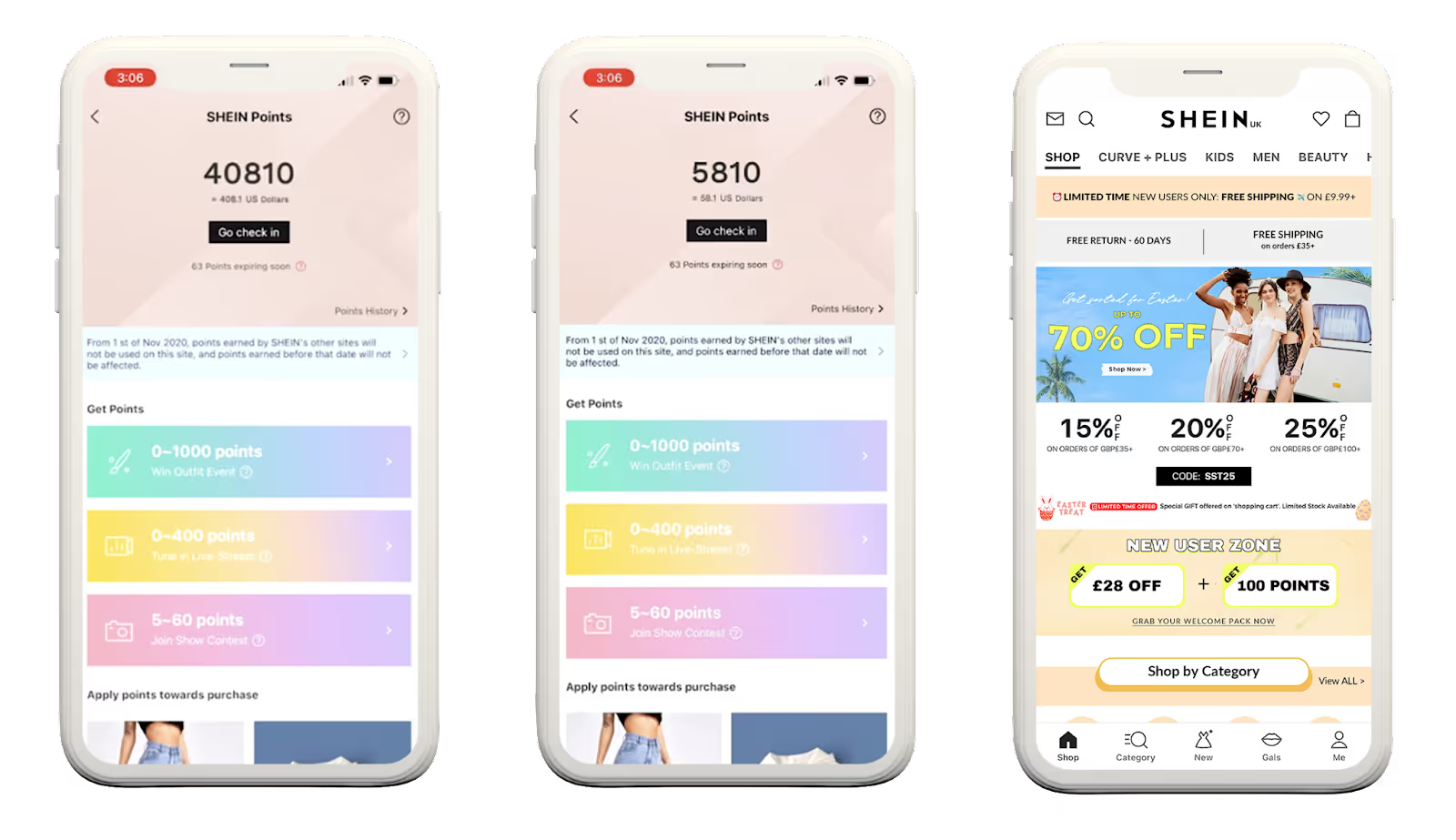
When it comes to redeeming points, customers can use them to deduct up to 70% of the total price of their order. They can also use the collected points to redeem coupons during special events or game opportunities.
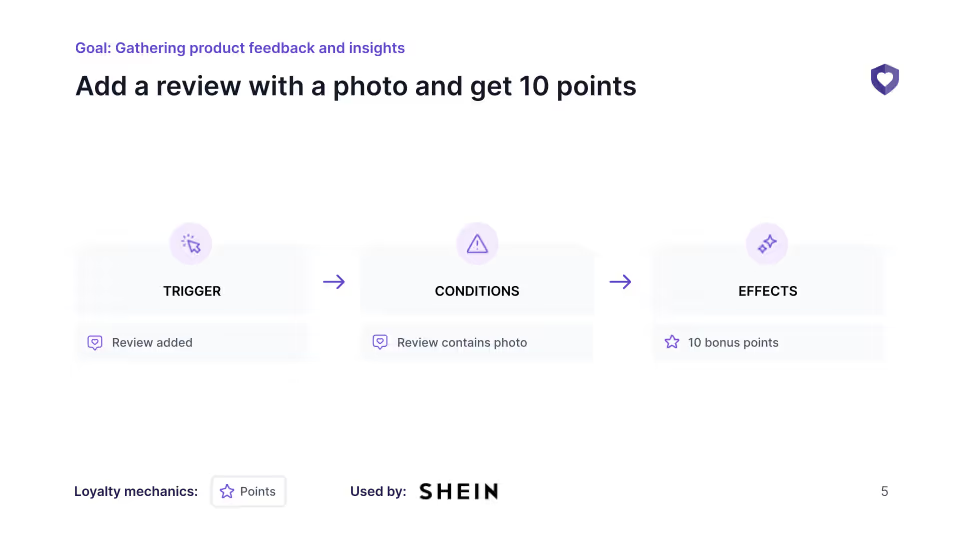
Sephora is a retail brand with a long history in the personal care and beauty industry. The company was founded in France in 1970 and since then has over 2,700 stores in 35 countries around the world. However, it didn't stop there. They continued to grow a base of over 500 stores in the Americas and a world-class eCommerce store.
Because the company has many die-hard fans, in 2007, they created a free Beauty Insider Program in the United States and Canada that allows customers to earn points for their purchases and redeem them for rewards.
The Beauty Insider Program consists of three tiers: Insiders, VIB, and Rouge. Customers earn one Beauty Insider point for every dollar spent, and the tiers, in this case, are tied to spending.
Shoppers can move up to the Insiders tier for free, but if they want to upgrade to the VIB or Rouge tier, they must consecutively make $350 or $1,000 in purchases. So, depending on the tier, there are many benefits associated with the three areas:
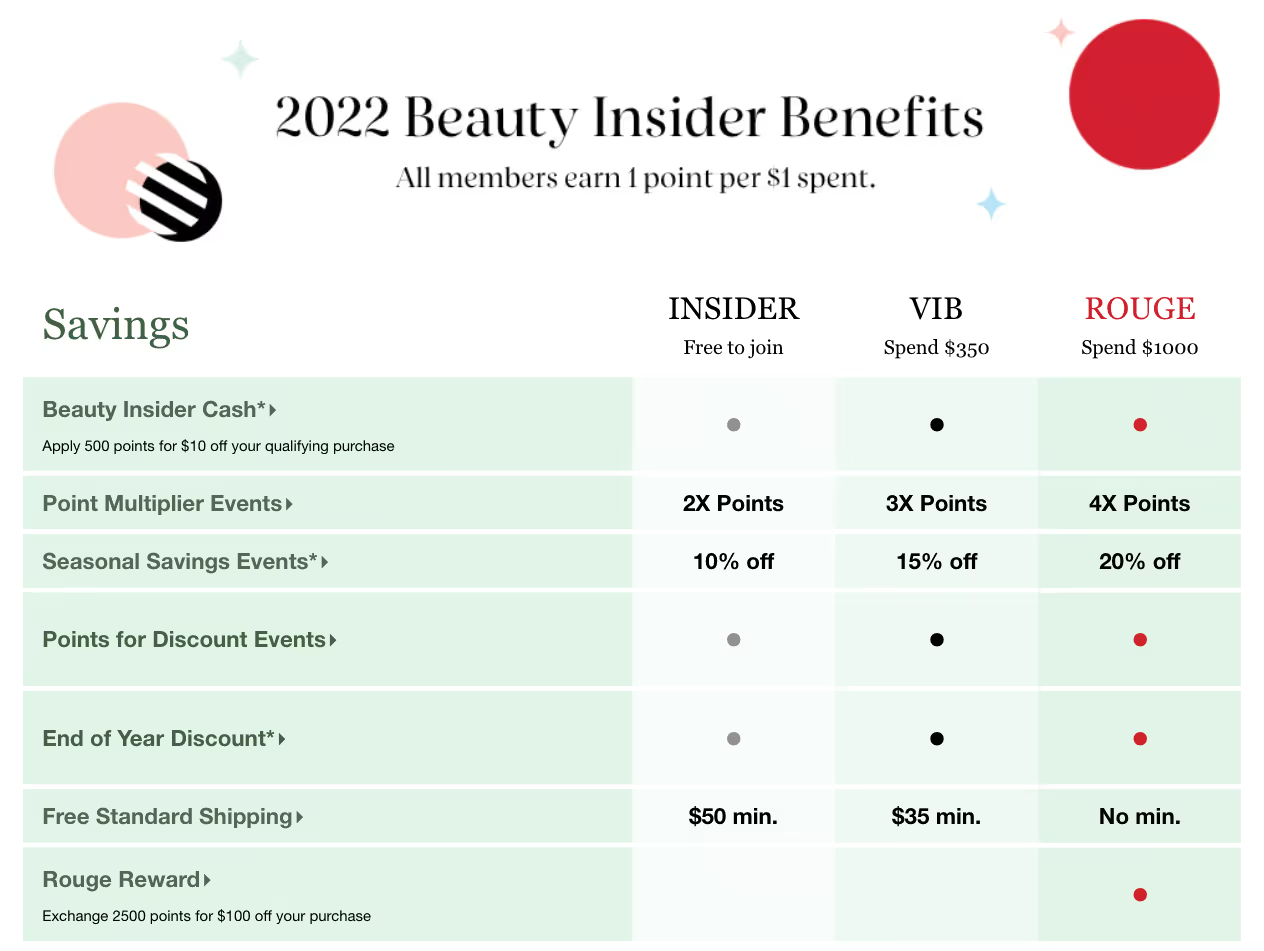
Every Sephora Beauty Insider member can also access Rewards Bazaar, a special online platform where they can redeem their points for various time-limited products or sets. Members can also join the Beauty Insider Community, a mobile and desktop platform where they can find other beauty lovers looking for inspiration, answers to questions, and product recommendations.
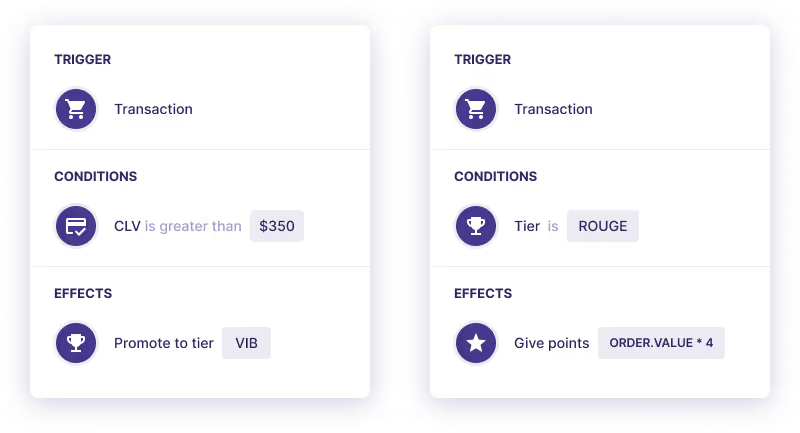
Alibaba stands as the largest ecommerce company in China, and arguably one of the biggest worldwide. Its ecosystem encompasses platforms like Taobao, Tmall, AliExpress, and Alibaba.com.
As of 2025 Alibaba serves a staggering 1.31 billion annual active consumers, including both domestic and international users. Also, its customer base spans Taobao and Tmall, with over 800 million monthly active users on these core platforms.
These numbers underscore Alibaba's dominant position in the global ecommerce landscape, fueled by its massive user base and seamless integration across retail, logistics, payments (via Alipay), and cloud infrastructure.
In 2018, Alibaba launched the "88 VIP" premium membership package as the next tier within the 88 Membership Club, a loyalty program for Tmall and Taobao marketplace customers. This tiered loyalty program was designed to reward the most loyal customers and offer exclusive member benefits across Alibaba's commerce, entertainment, and local service ecosystems. Frankly, they've really redefined building customer loyalty with this system.
Alibaba's customers need to pay an annual membership fee of 888 yuan (about $140) to be promoted to the "88 VIP" tier. Do you think they're willing to accept such a fee? Of course, because the perks are tempting.
The "88VIP" members can enjoy top-notch services across all platforms in the Alibaba ecosystem, specifically:
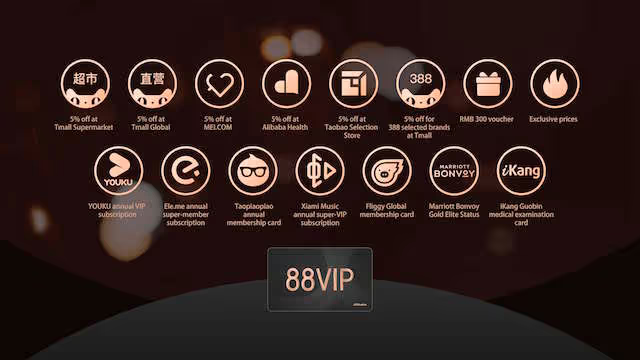
Loyalty managers increase usage of the "88VIP" program by taking advantage of Singles' Day on November 11 or June 18 Mid-Year Shopping Festival and giving even greater discounts. During the 6.18 Festival, sales generated through live streams hosted by retailers increased 100% year-over-year. In addition, brands on Tmall offer special deals for 88VIPs and early access to limited editions or new products.
What's more, the "88VIP" members are automatically enrolled in other membership programs within the Alibaba ecosystem, such as food delivery or travel booking services. They also achieve "Gold elite" status in the hotel loyalty program, making it easier for them to book a place at a budget-friendly price. The digital membership card offers access to free streaming of favorite movies, TV series, and music.
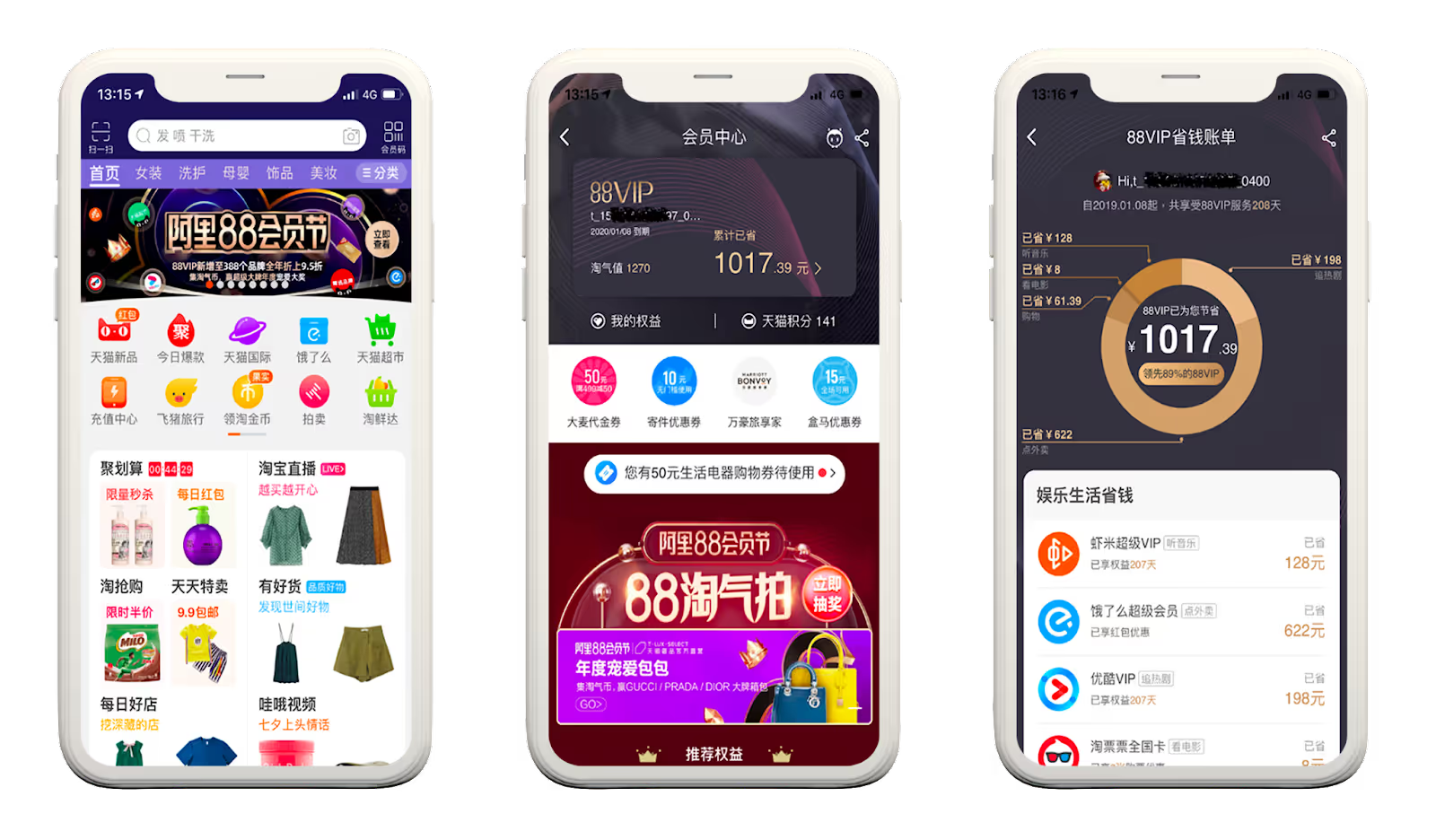
Alibaba has successfully created a special place with benefits that many people want to join. Miya Duan, Tmall Brand Marketing director and head of the "88VIP" program, claims that "88VIP" members spend twice as much money as other shoppers on the platform. And because they're also early adopters of new trends about six months before their official release, other consumers want to join the "88VIP" club to stay up to date and take advantage of the best prices.
Best Buy is a leading U.S. and Canadian electronics retailer, operating over 1,117 stores and employing approximately 100,000 people in North America. In fiscal year 2025, it generated about $41.4 billion in revenue, with ecommerce sales contributing roughly $12.98 billion in 2024 (≈ 39.5% of total revenue).
The company launched the My Best Buy eCommerce rewards system to strengthen customer relationships and make their shopping experience more rewarding.
Buyers earn points for every dollar spent on qualifying purchases in an eCommerce store, retail store, or a mobile app.

Customers can achieve three levels of membership: My Best Buy, My Best Buy Elite, and My Best Buy Elite Plus. There's no fee to become a member, and customers qualify for each level based on their annual spending at Best Buy. In this case, it's $1,500 per calendar year for Elite and $3,500 per calendar year for Elite Plus.
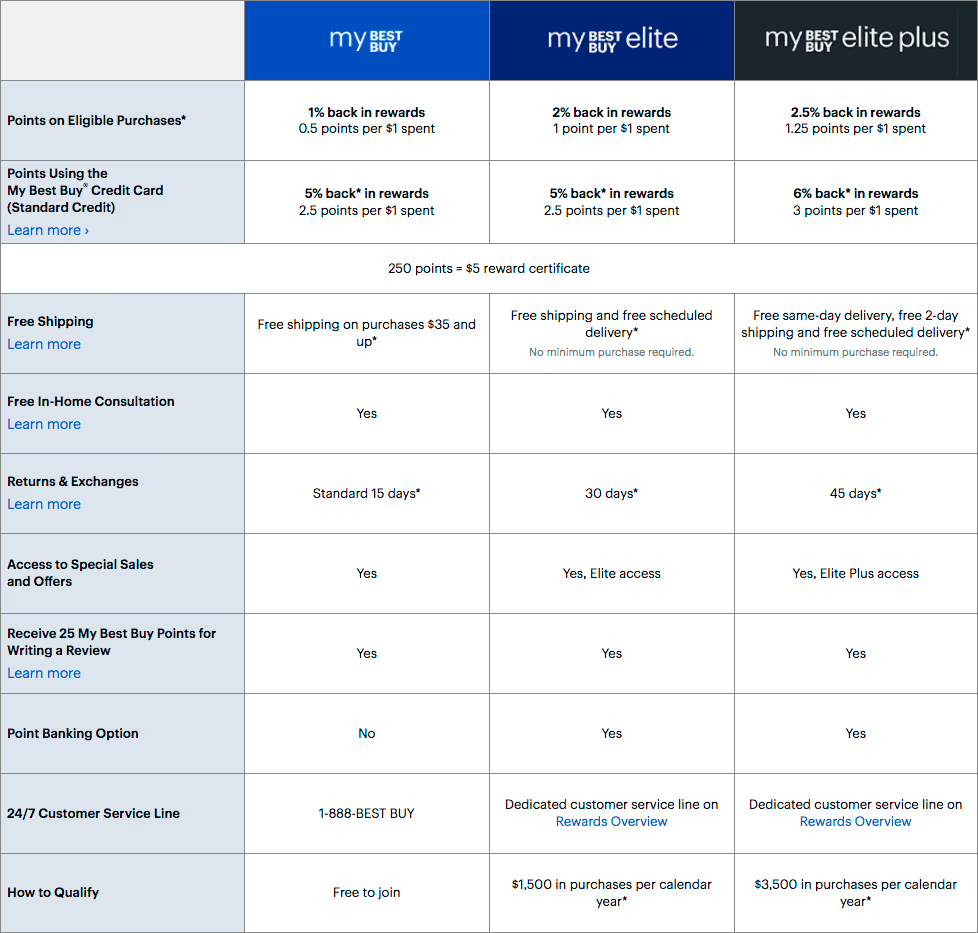
Members participating in the My Best Buy loyalty program can enjoy such benefits as:
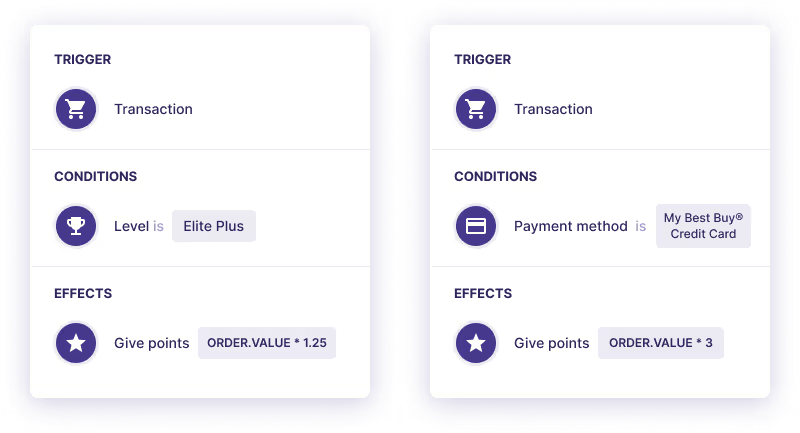
Zappos is a leading U.S. online retailer offering shoes, apparel, handbags, accessories, and more. In 2024, its ecommerce sales reached approximately $900 million, with projections indicating modest growth into 2025.
Zappos VIP, its free loyalty program, allows customers to earn 1 VIP Point per $1 spent on qualifying purchases. Members can also accumulate bonus points through promotional activities, like writing product reviews, logging in daily, or linking an Amazon Prime account (which grants double points).
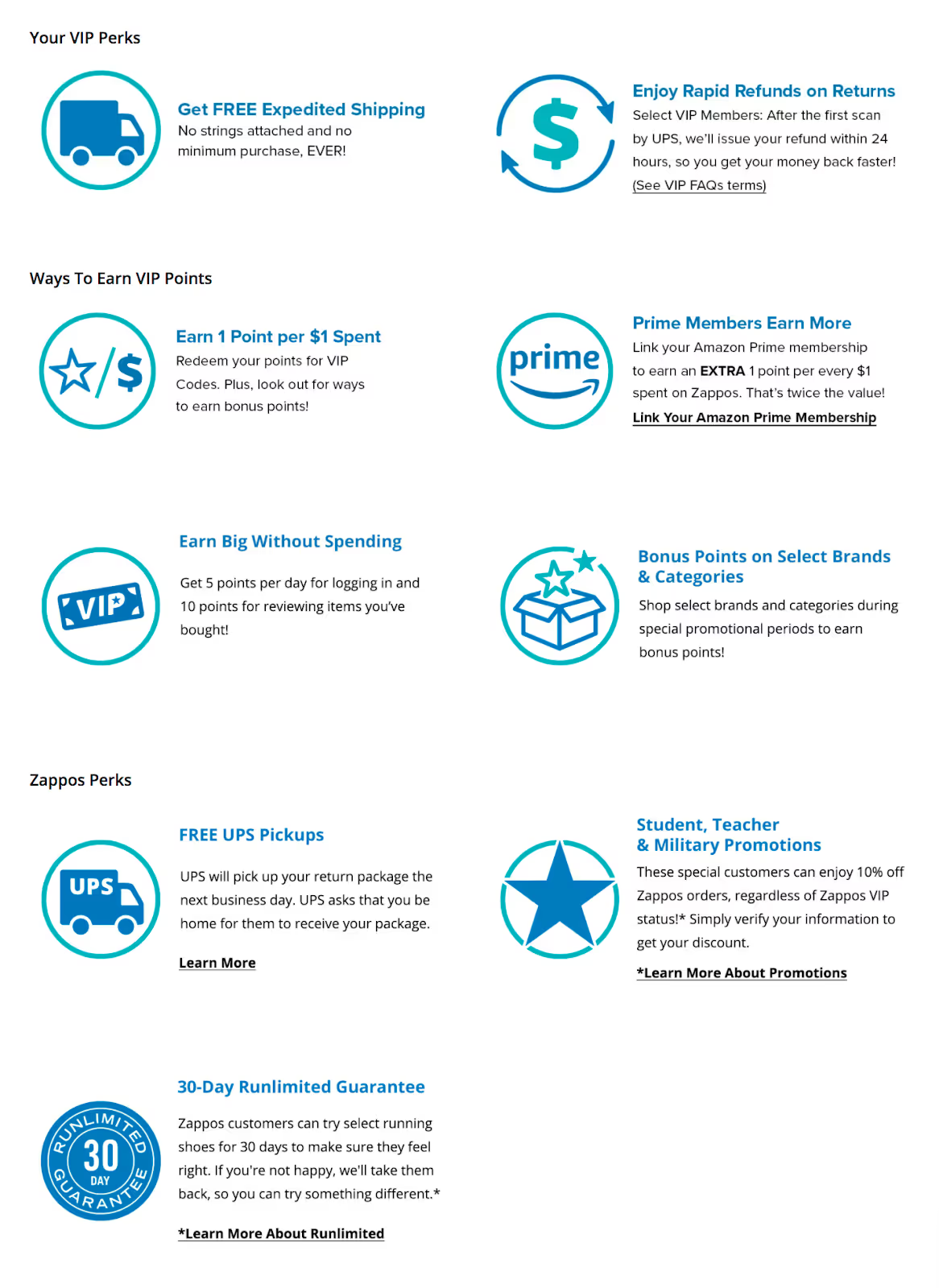
In addition to earning VIP Codes on purchases, existing customers can also enjoy several perks, such as:
An example of the Zappos VIP loyalty scheme that is based on coupons.
After analyzing ten standout examples, it becomes clear that the most effective online loyalty programs share a common set of design principles and technical capabilities. These principles are foundational elements that any modern eCommerce loyalty program software should support.
If you're planning a new loyalty program for your website or enhancing an existing one, consider the following elements critical for long-term success.
Successful loyalty programs online always begin with clarity. Customers need to understand how to earn rewards, track progress, and redeem benefits without friction. Overly complex rules discourage engagement, while well-designed website loyalty programs build trust and repeat participation through ease of use.
An effective online loyalty scheme is embedded directly into the eCommerce experience — not bolted on afterward. Everything from onboarding to point redemption should match the visual and functional flow of your store. The best eCommerce loyalty software ensures that users feel like they're interacting with one cohesive system rather than switching between platforms.
With mobile shopping continuing to rise, any online loyalty program must be fully optimized for smartphones and tablets. Features like point tracking, mobile wallet integration, and in-app reward notifications are now expected by users. Leading eCommerce loyalty program software solutions offer responsive designs and native mobile compatibility out of the box.
Customers interact with your brand across multiple platforms — web, app, email, and social media. A high-performing online loyalty strategy connects these touchpoints and maintains consistent logic and value across them. Advanced eCommerce loyalty software supports omnichannel tracking and engagement to ensure continuity and convenience.
If your brand has a physical presence or sends out products, use that opportunity to promote your online loyalty program. In-store QR codes, printed invitations in packaging, or digital displays can raise awareness. Even brands that operate exclusively online can benefit from offline campaigns that introduce their loyalty program for website users in real-world settings.
The most competitive loyalty programs online use behavioral data to personalize offers, recommend rewards, and target communications. Effective eCommerce loyalty program software includes capabilities for real-time segmentation, lifecycle campaigns, and personalized incentives that respond to customer habits and value.
There's no single "best" ecommerce loyalty program — the right one depends on your business model, customer base, and product type. That said, programs like Sephora's Beauty Insider, with its tiered reward structure and exclusive perks, and Flipkart Plus, known for free membership and ecosystem-wide benefits, are often cited as standout examples for customer engagement and retention.
Ecommerce loyalty programs reward repeat purchases and customer interactions with points, perks, or tier-based benefits. Customers accumulate rewards for actions like shopping, writing reviews, or referring others, which they can redeem for discounts, free products, or VIP experiences. These programs are designed to boost customer lifetime value, reduce churn, and encourage brand loyalty.
The most effective loyalty programs for ecommerce typically include:
When these elements come together, ecommerce loyalty programs can turn occasional buyers into long-term, high-value customers.
To sum up, eCommerce loyalty programs are a powerful tool for retaining customers, driving sales, and staying competitive in the market. By understanding the different types of customer loyalty programs, the key elements of success, and the strategies for boosting customer engagement and participation, you can design and launch a successful loyalty scheme that benefits both your business and your customers. Remember to continuously optimize, innovate, and maintain a customer-centric approach to ensure the long-term success of your eCommerce loyalty program.
By implementing the insights and tips discussed in this article, as well as using the market-proven loyalty campaign templates, you'll be on track to transform the shopping experience of all eCommerce users.

Get a weekly dose of actionable tips on how to build and grow gamified successful loyalty programs!




